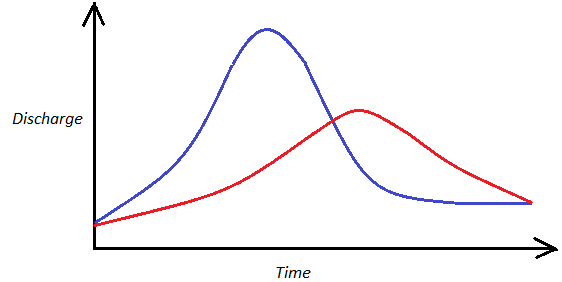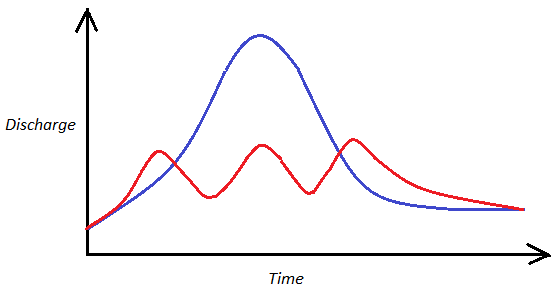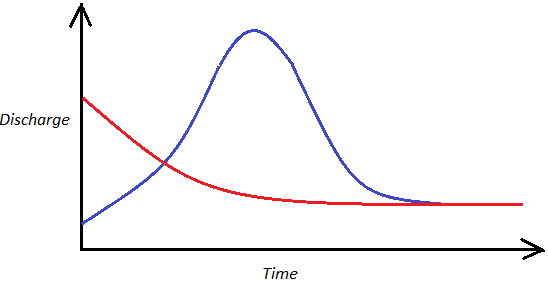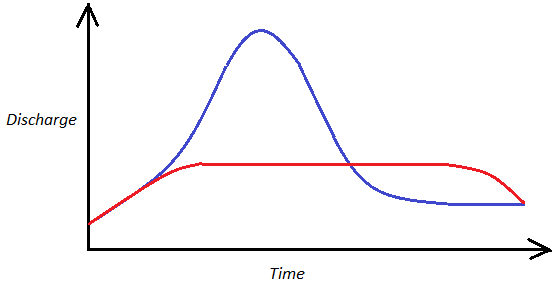This set of Engineering Hydrology Multiple Choice Questions & Answers (MCQs) focuses on “Flood Control”.
1. Which of the following is not a structural method of flood control?
a) Flood ways
b) Flood embankments
c) Flood plain zoning
d) Channel improvement
View Answer
Explanation: Structural methods of flood control involve the prevention of entry of flood into an area by building structures or modifying existing features to reduce the possibility of flood. These include flood ways, channel improvement, embankments, etc.
2. What is the main principle of non-structural methods of flood control?
a) Living with the flood
b) Constructing structures to prevent flood
c) Using the power of money to reduce flood
d) Laws to prevent inhabitation of flood prone areas
View Answer
Explanation: The main strategy of non-structural flood control includes the philosophy of trying to live with the flood. All the methods within non-structural flood control incorporate this principle in different ways.
3. Which of the following is a non-structural method of flood management?
a) Channel improvement
b) Flood forecasting
c) Watershed improvement
d) New channels
View Answer
Explanation: The method of flood forecasting involves people living in a region with the possibility of flood at any time, which adheres to the main principle of living with the flood. Hence, it is a non-structural method of flood management.
4. Compared to the given inflow hydrograph (blue), which of the following outflow hydrographs (red) best represents the functioning of a storage reservoir for flood control?
a) 
b) 
c) 
d) 
View Answer
Explanation: The hill portion of the inflow hydrograph represents the amount of flood water stored in the storage reservoir over time. The main principle of using the storage reservoir for flood control is to release the stored water in a controlled manner at a constant discharge, that is safe for the downstream channel, over an extended period of time.
5. The complete management of a flood event in a region to a level of zero loss is economically unfeasible.
a) True
b) False
View Answer
Explanation: There is always a small uncertainty in flood occurrence and analysis as it involves probabilistic and numerical approaches. Even if the results are completely accurate, physically implementing them would economically unfeasible compared to its benefit.
6. What is the disadvantage of a storage reservoir in flood control?
a) No control on release of water
b) They are multifunctional structures
c) Not available throughout the year
d) It requires lot of labor
View Answer
Explanation: Storage reservoirs have many important functions other than flood control. It requires the careful manipulation of storage levels to satisfy all its demands simultaneously. Hence, even though he reservoirs help to reduce flood damage, it does provide optimum results in the flood control aspect.
7. What is the best way to optimize the use of storage reservoir as flood control structures?
a) By selecting the best possible location for the reservoir
b) By increasing its storage capacity
c) Having multiple reservoirs at strategic locations
d) By employing trained and experienced personnel to operate the reservoir
View Answer
Explanation: A single storage reservoir may not give the best required output as a flood control structure due to its multipurpose commitments. Hence to achieve complete flood control, many reservoirs need to be built at strategic locations along the river or catchment with the specific purpose of flood control.
8. How are detention reservoirs different from storage reservoirs in flood control?
a) They have larger storage capacity
b) They have an uncontrolled outlet
c) They are more economical
d) They provide temporary storage
View Answer
Explanation: Detention reservoirs are built as obstructions to the flow of a river to provide temporary storage of the flood water. They are smaller structures and reduce the flood peak by discharging the stored water through an uncontrolled outlet.
9. Which of the following is not a non-structural method of flood management?
a) Watershed management
b) Flood warning
c) Evacuation
d) Flood plain zoning
View Answer
Explanation: Non-structural flood control does not involve the use of any method to prevent or reduce the effect of an incoming flood. It includes flood forecasting, flood plain zoning, evacuation, etc. Watershed management requires the modification of current features of the region to help reduce the effect of a flood event, and hence it is a structural method of flood control.
10. What is the main function of a levee in the aspect of flood control?
a) Restrict the flood within a fixed course
b) Store the flood water
c) Dissipate the energy of the flood water
d) Delay the arrival of flood to a region
View Answer
Explanation: Levees are earthen structures constructed parallel to the course of a river, on its banks, upto a suitable height. It helps in confine the flood water to a certain path and keep the flood level below the top of the levee.
Sanfoundry Global Education & Learning Series – Engineering Hydrology.
To practice all areas of Engineering Hydrology, here is complete set of 1000+ Multiple Choice Questions and Answers.
If you find a mistake in question / option / answer, kindly take a screenshot and email to [email protected]
